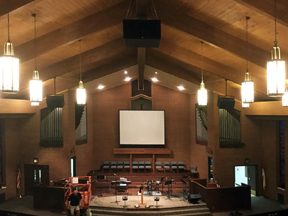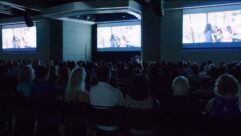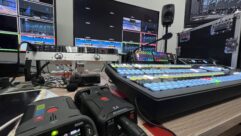
SVC Podcast – Show Notes – Show 159-2
In this edition of the SVC Podcast, SVC Contributing Editor Bennett Liles finishes his conversation with Scott Oliver, president of Centerline Audio Visual Company in Hendersonville, Tennessee about the total sound system renovation done for the First Baptist Church of Manchester. Scott provides details on the Danley SM-100B speakers used for main house and he discusses the Soundcraft Si Performer console used for FOH mixing.
For Part 1
Links of interest:
- Danley SM-100B speakers used for main house
- Danley BC-218 Subwoofer installed for the church
- Soundcraft Si Performer used for FOH mixing
Download Podcast Here:
https://s3.amazonaws.com/nb-svc/public/public/159-2_FBC_Manchester_Cente…
From Sound & Video Contractor Magazine, this is the SVC Podcast with Scott Oliver of Centerline Audio Visual Company. Show notes and equipment links for the podcast are on the web site of Sound & Video Contractor Magazine at svconline.com.
The First Baptist Church of Manchester, Tennessee completely revamped its sound system for live music and they had Centerline Audio Visual Company come over from Hendersonville to handle the job. At front of house they got a Soundcraft Si Performer and Danley speakers for the main house. Centerline AV President Scott Oliver is back to finish up the story on how it all got up and running. That’s coming right now on the SVC Podcast.
Scott, thanks for re-joining us for the SVC Podcast from Centerline Audio Visual Company in Hendersonville, Tennessee and we were talking in Part 1 about the First Baptist Church of Manchester. You did the complete sound upgrade so they could modernize their services with live music. What did you have to do when you first got access to the sanctuary? What was the timeline like on this one?
Well we find that in the house of worship market, and I’m sure a lot of people will relate to this, there’s a lot of hurry up and wait and then hurry up again. So basically this was, from the time that we came in and first saw the sanctuary and got some drawings, and of course it was an older building so I think the only thing we had was a floor plan. So we actually had to go in and measure everything else, the ceiling height and the pitch and all that stuff. But I would say overall from the time we started to the time we finished it was about six, seven months. Something like that. I mean basically once we started and only, you know, started doing the installation, it was, I don’t know, three days and we were done. But it was probably a good four or five days or a good week of doing Ease predictions. And we also did some of the predictions in Danley Direct. But again we got called and we did a design and we did the cost and then we handed that over to the church and then you have to wait a few months for them to approve it and then to actually pull the trigger. And that’s very typical in churches. Rarely will you find a church that you walk in and then they go great, start tomorrow. It just doesn’t happen that way. [Timestamp: 2:25]
Yeah, just lining up all the dominoes so you can knock that first one over on the installation and not hit any snags when it comes to running the cabling and doing the rigging.
The only snag we run into at times is if the church has a Wednesday night service. So sometimes we’re starting on a Monday. We have brought in speakers on sticks to help them get through that Wednesday night service while everything is sitting on the ground. Yeah, I mean we spend a lot of late nights. I Mean don’t get me wrong, man, we’re certainly not working 8:00 to 5:00. Definitely not banker’s hours. Lots of coffee. [Timestamp: 2:57]
The main attraction of this was the Danley speakers. I think you used the Danley SM-100B for the main house. What was the selling point on these? You’ve probably used them before.
Yeah, we have and like I was talking about last week I’ve spent a fair amount of time working in recording studios so I’m very attuned to what a reference monitor sounds like and the accuracy and detail and things like that. Those are the things that I look for. One of the things about all of the Danley line, but especially the SM-100B, is it sounds like a really beautiful reference monitor. It’s just a gorgeous-sounding speaker. There’s nothing about it that’s harsh. It’s very full-range. I think it goes down to maybe 50 Hz or something like that, but it’s just a very pretty, very beautiful-sounding cabinet without lying to you. It’s very accurate. If you’ve got a great console in front of it with great amplifiers and a great room, the next thing is there’s just nothing to it. It just will almost run itself. So it is a beautiful-sounding box. [Timestamp: 4:02]
And I think that probably another feature of the Danley speakers, since you don’t have the acoustic treatment in yet, is their ability to have a very tight pattern in keeping sound off the ceiling and walls.
A lot of times that’s determined during the prediction process especially if you’re trying to punch through bad acoustics. A conventional speaker design is – you’re always going to have time alignment issues somewhere in the room. There’s just no way around it. But the great thing about this energy horn design is it’s perfectly time-aligned from the time it leaves the front of the box. So your clarity in poor acoustics is great. It’s huge. Sometimes you’ll even hear people say we don’t even need acoustic treatments and that can be the case, but generally it’s because they have been listening to their old system for so long and this is such a drastic improvement that they think well hey, this is good enough. But once we actually do the acoustic treatments and they begin to sound like a big control room, then the game’s over. They’re completely convinced. I mean it works really well in a bad acoustic environment, but in a great acoustic environment it’s off the chart. [Timestamp: 5:11]
I’m sure it depends a lot on where you are in the room so where’s the front of house mixer located?
Unfortunately it’s in the balcony and it’s just based on the architecture of the room. There’s just nowhere else to put it. But that is where it’s at, it’s in the balcony.
I’ve been there and had to do that.
Oh yeah, it’s very common especially in churches that were built 40-50 years ago. [Timestamp: 5:32]
And I think it’s a Soundcraft Si Performer.
Yes.
How does that fit the situation of being operated by volunteers? Is it pretty simple for them to be able to operate it for the services without being intimidated?
Absolutely. I’ve been installing digital mixers since they were first introduced. The one disconnect that we had for years is the designers of digital consoles were in other countries. A lot of them were in England. We had some in France, Austria, Japan. And lot of these designers, they didn’t understand the worship culture in American churches. I’m not even sure they’re doing a lot of contemporary worship in England or France or Germany even today. And they didn’t understand that these were going to need to be operated by volunteers, but they did see the fact that there was a huge market for it. And they did finally start opening their ears and listening to suggestions, complaints, whatever. They did open their ears to the American marketplace. And the last generation, actually this newest generation of mixers, has gotten tremendously better. And the Soundcraft is – I don’t know how they could make it any easier than what it is now. The beautiful thing about it is consoles now are so easy to run that if I’m in a situation where I need to train someone how to use it I can now actually spend some time training them how to mix as opposed to just running the console. The earlier generations of consoles, they had so many menus and to get to an EQ you would have to go through four pages just to get to it or to make a configuration change. And a lot of people became very intimidated and very frustrated because just operating the console you felt like you were flying by the seat of your pants. Now 15-20 minutes, an hour with someone and they’re using the console but they can also focus on the actual craft and art of mixing. Any good tool that you use is going to allow you to use it for its purpose not just use the tool. The Soundcraft does a phenomenal job. [Timestamp: 7:50]
In this church you’ve got brick walls, you’ve got a lot of beautiful exposed wood beams on the ceiling and you don’t want to spoil that with the rigging. Who did all of the rigging on this one for you?
We used Barlow Harlin of Harlin Technical Services out of Bowling Green, Kentucky. He’s a certified rigger. Unlike a lot of other riggers Barlow actually comes out to the job site weeks before and he has a full fabrication shop and he goes back and fabricates all the rigging – the mounting plates and the cabling and everything. He fabricates every bit of it before he comes to the job site. When he shows up he’s already aware of what kind of challenges he may have and he’s already thought of them. I hand him the Ease coordinates and we step back and wait for him to ask questions, which generally he doesn’t really ask many. He just puts it in and he hangs around while we’re doing calibration for any minor tweaks. But he’s a true professional and he really knows what he’s doing. [Timestamp: 8:54]
It’s great when you can call a good name you can depend on for rigging. I also noticed on the picture they have a big projection screen right in the middle. Is that a front or rear screen projection?
It’s front projection. And as a matter of fact, yeah, that projector is getting pretty long in the tooth. We’re going to be replacing that probably before the holidays for sure.
Okay, ongoing improvements. But when you got all of that rigged up, how did you test the system?
We put pink noise through it and we used Smart Live and Earthworks mics and we basically do the alignments just like you would any other system. And then of course a lot of listening. We’re like anybody else. We have our certain play list of music we like to play through the system. And then we will show up for the first maybe through the second service while they’re getting acclimated to it and if something needs to be changed or if we felt like we missed something or should have done something different, we come back in later in the week after the service and apply a few tweaks. But if you guess at it you’re always going to put too much of everything in the project. But if you design it properly you don’t have a lot of speakers in the room. I mean ultimately my goal is to have sort of like a recording studio control room. You’ve got a left monitor and a right monitor. And for the biggest part of the room I want it covered by those two mains. Now if we need down fills we may add those or if we need wings or something we may add those. But I want at least 90 percent of that room covered by just two speakers. And when you do it like that what you have is you have almost no disruptive interference and when you go to calibrate it’s a piece of cake because you’re not fighting so many different sources and you’re not fighting phase cancellation and things like that. It’s just not present. So the proper design ends up making calibrations – it’s almost nothing to it. And the proof is in the pudding, you know? You listen to it either with tracks or a band or whatever and people are commenting that hey, the bad sounds like a CD. Well, we know we did our job right. [Timestamp: 11:08]
And then you have the big test on the first live service. How did all of that go?
It went great. Everyone was just tickled pink. They were finally understanding what was being said and what was being sang. See before this they didn’t even have subwoofers and we got that big Danley DBH218 up there so now they’re enjoying a bottom end that they never had. And then there’s some churches that actually believe the Holy Spirit lives in the subwoofers and so when you get it kicking, that’s when people start clapping their hands and raising their hands. And when we see that too we know we did our job right. When the overall worship experience is such that the entire congregation is engaged regardless of their age then we feel safe with turning the keys over to the owner and leaving it with them to use week after week when we’re not there. [Timestamp: 12:00]
Great when you can do that and you know it’s going to work right. So what have you got coming up on the projects list?
I’m actually looking at a dry erase board in my office. I’ve got about 14 projects that are due to start any time. I’m really hoping they don’t all start at once, but we’ve got a lot coming up. This entire summer and even through the spring there’s been a lot of engineering time; a lot of time sitting at a computer and staring at an Ease model and spreadsheet and price lists and phone calls and meetings and all that sort of stuff. So we are actually ready to get out of the office for a while and spend some time on the job. [Timestamp: 12:39]
You got all the dominoes lined up and it’s nice to go in and knock that first one over and see what happens.
Oh, yes. Yes.
The First Baptist Church of Manchester, Tennessee. A total sound system upgrade done by Centerline Audio Visual Company and Scott Oliver, the president. Thanks for the details. You made it sound simple but I know it’s never really that easy.
When it’s all you do every day it gets easier as time goes, but yeah no two are the same that’s for sure. Every one presents a different set of challenges.
Okay. Thanks for giving us the story on it, Scott.
Hey, thank you so much. All the best.
It was great to have you here for the SVC Podcast with Scott Oliver. Show notes and equipment links are on the website of Sound & Video Contractor Magazine at svconline.com. Be right back here with us next week the SVC Podcast.










